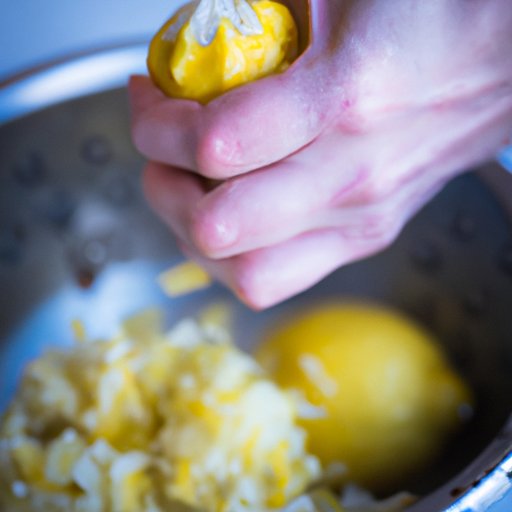Zesting Lemons: How to Add Flavor and Zing to Your Dishes
If you love to cook, you probably know that sometimes the littlest things can make the biggest difference to a recipe. That’s just what lemon zest can do, adding a burst of bright, tangy flavor to anything from baked goods to cocktails. But if you’ve never tried zesting a lemon before, it can seem a bit daunting. In this article, we’ll walk you through everything you need to know about zesting lemons: from step-by-step instructions to variations, benefits, types, and ingredient substitutions. So let’s get started!
Step-by-step Guide to Zesting a Lemon
The first thing you’ll need is a zester, a microplane, a grater, or a peeler. Each tool will result in a different texture of zest, so choose your tool based on the recipe you’re cooking. For this guide, we’ll focus on using a zester, which will give you light, delicate strands of zest.
Start by choosing a fresh lemon. To get the most zest, choose lemons that are firm and bright yellow, with a slight shine. Wash and dry the lemon before zesting.
Hold the zester lightly in one hand and the lemon firmly in the other. Place the zester against the lemon and pull it across the surface, applying light pressure. Skim the zester across the surface of the lemon, working your way around the fruit in long strokes. Try to avoid the bitter white pith just under the yellow skin.
Continue to zest the lemon until you have enough zest for your recipe. Most recipes will call for 1-2 teaspoons of zest, but you can always add more if you want a more intense lemon flavor.
Video Tutorial: How to Zest a Lemon
Still feeling unsure about zesting a lemon? Check out this video tutorial that demonstrates the different techniques of zesting a lemon:
Additional tips and tricks mentioned in the video tutorial include: how to soften a lemon before zesting and how to get a different texture of zest.
Cooking Applications of Lemon Zest
Lemon zest works well in both sweet and savory dishes. One popular recipe that incorporates lemon zest is lemon zest cookies. Here’s how to use lemon zest in the cookie recipe:
- 2 cups all-purpose flour
- 1/2 teaspoon baking powder
- 1/2 teaspoon salt
- 1/2 cup butter
- 1/2 cup sugar
- 1 egg
- 1 teaspoon vanilla extract
- 1 tablespoon lemon zest
Cream the butter and sugar together until light and fluffy. Beat in the egg and vanilla extract. In another bowl, whisk together the flour, baking powder, and salt. Gradually stir the dry ingredients into the creamed mixture until incorporated. Fold in the lemon zest. Roll into balls and bake at 350°F (180°C) for 12 to 15 minutes.
Another delicious way to use lemon zest is in a salad dressing. Simply whisk together 1/2 cup olive oil, 2 tablespoons lemon juice, 1 tablespoon honey, 1 teaspoon Dijon mustard, and 1 teaspoon lemon zest. Serve over your favorite greens.
Variations of Zesting and Their Benefits
Aside from a zester, you can also use a microplane or grater to zest a lemon. Each method will result in a different texture of zest. A zester produces thin, delicate strips of zest, while a microplane creates fine, fluffy shreds. A grater makes thicker, coarser shreds.
The choice of tool will depend on the recipe you’re cooking. For a delicate dish like lemon zest cookies, opt for a zester. If you’re making a spicy lemon marinade, a microplane or grater may be better to achieve a more intense flavor.
Benefits of Lemon Zest and its Unique Flavor
What makes lemon zest unique is its bright, zingy, and refreshing flavor. It can enhance the citrus flavor in a dish without adding liquid like lemon juice does. Lemon zest also contains essential oils that can add an aromatic quality to the dish. Plus, it’s packed with antioxidants and vitamin C, making it a healthy addition to your cooking.
Types of Lemons for Zesting
Two types of lemons that are commonly used for zesting are Meyer and Eureka lemons. Meyer lemons are sweeter and less acidic than Eureka lemons, and as such, they may be better for baking or using in cocktails. Eureka lemons are more tart and are often used in savory dishes like marinades or dressings.
You can use whichever type of lemon you prefer! Just keep in mind that the different types of lemons can add different flavors and intensities to your dishes.
Ingredient Substitutions for Lemon Zest
If you can’t find lemons or want to mix up the flavor profile, there are a few substitutions you can make for lemon zest. Lime zest is an excellent alternative for most recipes. In a margarita mix, use lime zest instead of lemon zest to switch up the flavor. Alternatively, orange zest can be substituted for lemon zest in a salad dressing.
Keep in mind that the flavor profile will change when you substitute another zest for lemon zest. Be prepared to adjust the recipe to account for this.
Conclusion: Tips and Tricks for Zesting Lemons
Hopefully, this guide has made zesting a lemon less daunting. Keep in mind that it takes practice to master, so don’t be afraid to experiment.
